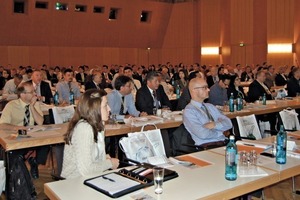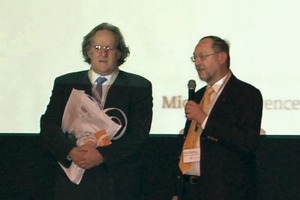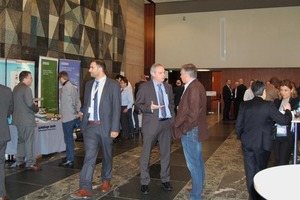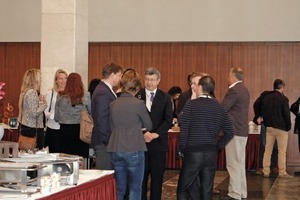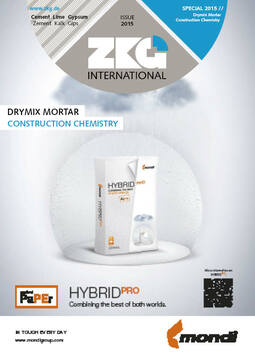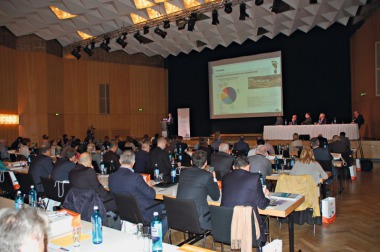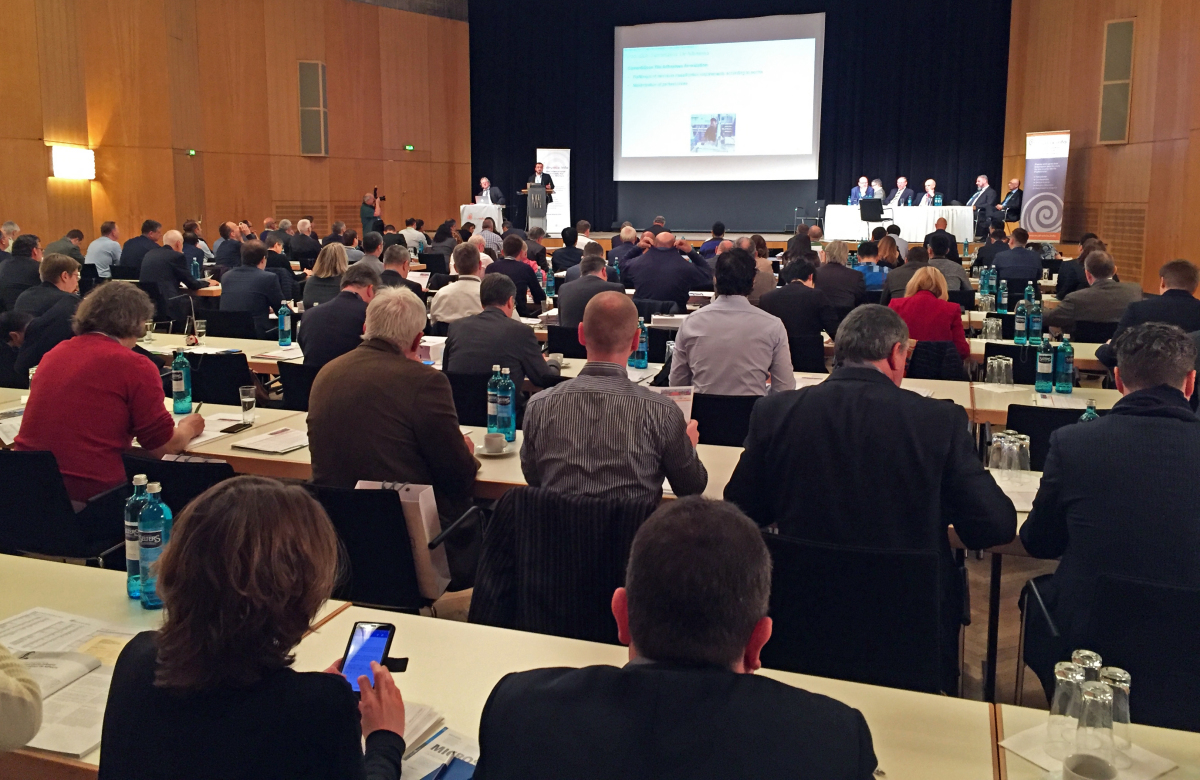The drymix mortar community keeps itself well informed
For the fifth time, Ferdinand Leopolder of drymix.info issued an invitation to the International Drymix Mortar Conference (idmmc five) in Nuremberg on 20.04.2015. This event for the international drymix mortar community takes place every two years. As in recent years, the date was coordinated with the European Coatings Show, which was held immediately afterwards in Nuremberg. On the evening before the conference, the majority of the drymix mortar community already met for a convivial evening at the Nuremberg Barfüßer Mautkeller tavern, originally a granary built in 1500. The rustic ambience and relaxed atmosphere presented an early opportunity to exchange experience and engage in networking.
Ferdinand Leopolder, together with the Technical Chairman, Prof. Dr. Johann Plank of the Technical University of Munich, were then able to welcome more than 175 participants in the small Meistersingerhalle on 20.04.2015. The conference was accompanied by an industry exhibition, at which plant manufacturers and suppliers for the mortar industry presented their products and were available for questions from interested parties.
The conference started off with a presentation by Matteo Monaco, Mapei S.p.A, Milan/Italy, entitled “Statistical evaluation of pull-off adherence tests according to ISO 13007”. Data dispersion is the fundamental parameter when choosing a well performing substrate. The distribution of adhesion pull-off data on different substrates was analyzed statistically. This was supported by a round robin test between three laboratories of the Mapei Group.
Dr. Marga Perello, Dow Europe GmbH, Horgen/Switzerland, spoke on the subject of a “New generation of binders for 2K fast drying waterproofing membranes”. The fast curing of a waterproofing membrane is an important attribute with regard to the cost and time expended when applying a second membrane. The aim was to develop new latexes combined with a fast drymix that ensure a superior waterproofing performance, very high flexibility and crack bridging, as well as elongation retention after water swelling.
“Calcium sulphoaluminate based cements: a sustainable solution for dry mortar production” was the title of the lecture by Dr. Maurizio Iler Marchi, Italcementi Group, Bergamo/Italy. Calcium sulphoaluminate cements (CSA) have recently become regarded as “green” binders, as they generate a small amount of CO2 during the clinkering process and during grinding. In addition to this, they are made by using a wide range of industrial by-products. Therefore, CSA cements could be used as main or secondary constituents in different applications. After showing different examples of applications, the main advantages of CSA cements for drymix mortar production were presented.
Prof. Dr. Johann Plank acted as chairman of the first lecture session. He also moderated the subsequent lively discussion on the individual contributions. All in all, the conference was characterized by the very high quality of the presentations and the ensuing discussions.
The second series of lectures was chaired by Mario Kriteller, MCK Consulting, Brazil. Dr. Ömer Faruk S¸en, Organik Kimya San. ve Tic. A.S¸., Istanbul/Turkey, presented the “Effects of redispersible powder polymers’ Tg on the flexibility of cementitious mortars”. The study was based on the well-known discussion on the effects of the glass transition temperature of polymers on the flexibility of cementitious mortars. The study tried to find a different set of definitions of flexibility, while introducing results from a different test method approach.
“Performance and hydration behavior of supplementary cementitious materials in tile fixing application” was the subject dealt with by Dr. Funda Inceog˘lu, Kalekim A.S¸, Istanbul/Turkey. This study investigated the benefits and limitations of supplementary cementitious materials (SCMs) as partial substitution for Portland cement in tile fixing applications. Mortars containing different amounts of SCM were examined by X-ray diffraction (XRD) and scanning electron microscope (SEM) analysis with regard to their impact on cement hydration behaviour and phases developed during the hydration reactions.
Dr. Markus Müller, Sika Services AG, Baar/Switzerland, lectured on “Targeted adjustment of mortar properties by use of polycarboxylates in various binder systems”. Applications that require excellent flow characteristics were the basis for the evaluation of suitable new polycarboxylate ether (PCE) based superplasticizers. Typical applications are grouts and self-levelling compounds which are based on cement, gypsum and ternary binder systems. Additives with a broad spectrum of applications are necessary for the purposes of the drymix mortar industry. Both environmental and economic aspects also have to be considered by the manufacturers.
In the last lecture before the lunch break, Nikolaus Kreuels, Calucem GmbH, Mannheim/Germany, spoke about “CAC-rich self-levelling compounds with different calcium aluminate cements”. The technical properties of CAC-rich self-levelling compounds (SLC) were investigated, replacing the CAC by different CAC grades in order to measure the variations in the SLC performance.
The series of lectures after the lunch break was chaired by Rainer Ålgars, a former research engineer at Saint Gobain Weber Finland and member of many technical committees dealing with the standardization of drymix mortars. Dr. Roger Zurbriggen, Akzo Nobel Chemicals AG, Sempach/Switzerland, started the session with the topic “Innovations in dry mortar technology to meet latest regulations and recent trends”. As the drymix mortar producer has to react to new requirements (trends, environmental implications etc.), the presentation focused on organic additives regarding formulation parameters. The relations between the additives and mineral binders and the resulting properties of drymix mortars were discussed from a material science perspective.
The presentation by Dr. Ulrike Peter, Lhoist S.A., Wawre/Belgium, was titled “On the impact of hydrated lime in drymix mortars”. The paper reviewed the current scientific state of the art regarding the performance of air-lime-based mortars. The impact of lime on mortar properties and performance, as well as its environmental benefits, were presented.
Axel Giesecke, Dow Corning GmbH, Wiesbaden/Germany, subsequently lectured on “Innovative options for cement-based material protection – from FRC to drymix”. Different new materials were presented together with their performance data. By comparing lab data of traditional and innovative methods, the aim was to show how innovative technologies can improve the performance of cement-based materials.
The first series of afternoon lectures was concluded by Dr. Klas Sorger, Wacker Chemie AG, Munich/Germany, “A comparison of different cement types – CEM I, CEM II and CEM III – in tile adhesives and ETICS mortars”. Due to environmental considerations, there is a change in the requirements for cement qualities when used as hydraulic binder in drymix mortars. The study compared different cement types with pure Portland cement in cementitious tile adhesives (CTA) and ETICS mortars.
The last series of lectures was chaired by Ferdinand Leopolder of drymix.info, the International Community for Drymix Mortars. Dr. Paul Nommensen, Avebe U.A., Veendam/The Netherlands, spoke on the subject of “Controlled shear history in rheological characterization of cement- und gypsum-based construction materials”. The study was based on an especially developed measuring protocol that imposed a fixed shear history on the sample material.
The next lecture was presented by Pascal Taquet, Kerneos S.A., Neuilly Sur Seine/France, and dealt with “Calcium aluminate as key technology for ettringite formation – from hydration to applicative properties”. The paper gave an overview of the different hydration reactions involved in ettringite formation and the link with applicative properties.
The conference was brought to a conclusion by the lecture held by Ludo van Nes Blessing, Caltra Nederland BV, Mijdrecht/The Netherlands, entitled “Metakaolins produced through flash calcination”. Metakaolins are traditionally manufactured by the rotary kiln method. The paper presented the results of the alternative production of metakaolin by flash calcination.
After a discussion of the topics, Ferdinand Leopolder wrapped up and summarized idmmc five. He cordially invited the participants to the next International Drymix Mortar Conference in two years’ time. The idmmc six will take place on 03.04.–04.04.2017 in Nuremberg.
//www.drymix.info" target="_blank" >www.drymix.info:www.drymix.info

